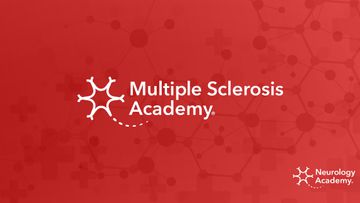Hot topic – strategies for remyelination in MS
Event reportsAn introduction that Jeffrey Huange gave in the final presentation sets a good scene for what we know so far which are prompting this investigation into lesion development and de/remyelination:
- There are insufficient oligodendrocytes despite the presence of OPCs
- MS worsens despite the reduction in radiological activity
- Many patients progress despite disease-modifying therapies
- There are an increased number of chronic active smoldering lesions
The presenters looked at different elements of remyelination:
- Veronique Miron demonstrated that neuroprotective NrF2 functions within astrocytes may be at odds with remyelination. She shared that, whilst NrF2 is known to be anti-inflammatory and neuroprotective, and is a focus of some MS therapies, her team have found that sustained NrF2 in astrocytes impairs remyelination.
- Mikeal Simons looked at remyelination in the central nervous system and proposed that there may be an optimal window of time where inflammation can be targeted to allow remyelination to occur.
- Finally, Jeffrey Huang suggested that targeting inflammation in amino acid enables remyelination in the central nervous system. His team inhibited an amino acid transporter, Slc7a5, which seems to regulate inflammation in demyelinated lesions. This resulted in increased oligodendrocytes in lesions and a 2-fold reduction in proinflammatory microglia/macrophages.
Veronique Miron presented some recent research on astrocytes and their effect on remyelination.
She noted that:
- Astrocytes are changing during efficient remyelination
- Astrocyte translatome dynamically changes during efficient remyelination
- Astrocytes show enrichment of NrF2 - something which is anti-oxidant, neuroprotective and anti-inflammatory and is a focus of some existing MS therapies.
- Astrocytes show enrichment of cholesterol biosynthesis pathways at onset of oligodendrocyte differentiation
They hypothesised that NrF2 needs to turn off in astrocytes for cholesterol pathways to turn on and found that sustained NrF2 in astrocytes impairs remyelination.
They found:
- controlled NrF2 activation in astrocytes regulates remyelination
- there is an inverse relationship between cholesterol and NrF2
- we need to consider complementing neuroprotective NrF2 functions with pro-remyelinating strategies
Key references:
Jäkel S, Agirre E, Mendanha Falcão A, et al. Altered human oligodendrocyte heterogeneity in multiple sclerosis. Nature. 2019;566(7745):543-547. doi:10.1038/s41586-019-0903-2
Wheeler, M.A., Clark, I.C., Tjon, E.C. et al. MAFG-driven astrocytes promote CNS inflammation. Nature 578, 593–599 (2020). https://doi.org/10.1038/s41586-020-1999-0
Schirmer, L., Velmeshev, D., Holmqvist, S. et al. Neuronal vulnerability and multilineage diversity in multiple sclerosis. Nature 573, 75–82 (2019). https://doi.org/10.1038/s41586-019-1404-z
van Horssen J, Drexhage JA, Flor T, Gerritsen W, van der Valk P, de Vries HE. Nrf2 and DJ1 are consistently upregulated in inflammatory multiple sclerosis lesions. Free Radic Biol Med. 2010;49(8):1283-1289. doi:10.1016/j.freeradbiomed.2010.07.013
Mikeal Simons presented on the mechanism of remyelination in the CNS. He shared that age is an important factor in recovery with people aged under 40 more effectively able to recover from lesions. In mice, those aged 12 months had larger lesions after injection than those aged 2 months.
- Mikeal demonstrated that age impacts the reverse cholesterol pathway. Inflammation has to resolve for oligodendrocytes to remyelinate and in older patients this ability to resolve inflammation is more impaired.
- There might be a window of time / age where inflammation can be targeted to allow remyelination to occur
Key references:
Cantuti-Castelvetri L, Fitzner D, Bosch-Queralt M, Weil MT, Su M, 'Defective cholesterol clearance limits remyelination in the aged central nervous system', Science, 09 Feb 2018: Vol. 359, Issue 6376, pp. 684-688 DOI: 10.1126/science.aan4183
Sim, M., Lyoo, I., Streeter, C. et al. Cerebellar Gray Matter Volume Correlates with Duration of Cocaine Use in Cocaine-Dependent Subjects. Neuropsychopharmacol 32, 2229–2237 (2007). https://doi.org/10.1038/sj.npp.1301346
Absinta, M., Sati, P. & Reich, D. Advanced MRI and staging of multiple sclerosis lesions. Nat Rev Neurol 12, 358–368 (2016). https://doi.org/10.1038/nrneurol.2016.59
Jeffrey Huang presented on aAmino acid transport in microlgia to support remyelination. Ongoing neuroinflammation suggests ongoing disease progression, and that the environment in the CNS is not ideal for remyelination to occur.
A neutral amino acid transporter, Slc7a5, was upregulated in microglia / microphages in demyelinated lesions at 5 and 10 days after injury.
The researchers questioned whether Slc7a5 regulates inflammation in demyelinated lesions. They administered an Slc7a5 inhibitor, JPH203, after demyelination and found:
- a 2 fold reduction of proinflammatory microglia/macrophages
- does not appear to deplete or kill microglia but to decrease their inflammatory state
- injecting the Slc7a5 inhibitor reversed microglia from a pro-inflammatory state to a homeostatic state
- increased oligodendrocytes in lesions
Their ultimate conclusion is that reducing amino acid fueled inflammation through Slc7a5 inhibition improves CNS remyelination.
Key references:
Baydyuk M, Cha DS, Hu J, et al. Tracking the evolution of CNS remyelinating lesion in mice with neutral red dye. Proc Natl Acad Sci U S A. 2019;116(28):14290-14299. doi:10.1073/pnas.1819343116
Related articles
Encouraging excellence, developing leaders, inspiring change
MS Academy was established five years ago and in that time has accomplished a huge amount. The six different levels of specialist MS training are dedicated to case-based learning and practical application of cutting edge research. Home to national programme Raising the Bar and the fantastic workstream content it is producing, this is an exciting Academy to belong to.

